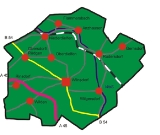
Wilnsdorf
Encyclopedia
Wilnsdorf is a municipality in the district of Siegen-Wittgenstein
, in North Rhine-Westphalia
, Germany
.
, form not only the community's highest point, at 579 m above sea level
, but also the boundary between Hesse
(Lahn-Dill-Kreis
) and North Rhine-Westphalia. The heights lie between 290 m above sea level and 579 m at the Kalteiche.
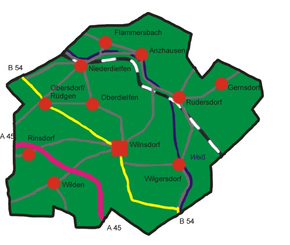
Niederdielfen and Oberdielfen are named for the River Dielfe, which flows through them. Niederdielfen was also the home of the painter Adolf Saenger, after whom the street Adolf-Saenger-Weg in Niederdielfen is named.
named Wieland (also known as Weyland
in English
) who, according to local lore, lived nearby. It is true that iron
mining
and smelting
had their beginnings in Wilnsdorf, and throughout the Siegerland, many centuries ago. History first mentions a mine in what is today the community's municipal area in 1298.
Between the late 12th century and the mid 17th century, the castle
and stately home of the Knights of Kolbe were to be found in Wilnsdorf. They were at this time the Vögte ( ≈ reeves) of the Princes of Nassau-Siegen over broad parts of the Siegerland. In Napoleonic Times, Wilnsdorf, like the rest of the Siegerland, lay under the rule of the Grand Duchy of Berg
.
In the early 19th century, the communities of Eisern, Obersdorf-Rödgen, Rinsdorf, Wilgersdorf, Wilnsdorf, Niederdielfen and Oberdielfen, by now all in Prussia
, were united under the Amt
of Wilnsdorf. Later, the community of Wilden, formerly part of the Amt of Burbach, was also included in the Amt of Wilnsdorf.
In 1957, mining in Wilnsdorf came to an end, and the last iron mine was shut down. On 1 January 1969, the formerly independent municipalities in the Amt were united to form the greater community of Wilnsdorf, the only exception being Eisern, which went to the town (now city) of Siegen
. The municipal head from 1969 until 2004, first as community director and then as mayor, was Karl Schmidt, who after retiring was made the community's first honorary citizen.
 The council's 36 seats are apportioned thus, in accordance with municipal elections held on 26 September 2004:
The council's 36 seats are apportioned thus, in accordance with municipal elections held on 26 September 2004:
Note: UWG is a citizens' coalition.
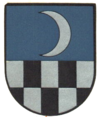 Wilnsdorf's old coat of arms
Wilnsdorf's old coat of arms
showed a crescent in the chief, but these arms were dropped in 1969 after amalgamation, losing their legal validity http://www.wilnsdorf.de/allgemeines/p_geschi.htm, and the current coat of arms, identical to that formerly borne by the now abolished Amt of Wilnsdorf, might heraldically be described thus: Party per fess, above, in azure a lion rampant Or armed and langued gules with seven billets Or, below, party per fess, above in argent two pallets sable, below, in sable two pallets argent.
The lion is from Nassau's arms, the colours blue and gold (or yellow) being Nassau's colours. The lower part of the shield comes from the arms of the Knights of Kolbe.http://www.ngw.nl/int/dld/w/wilnsdor.htm
museum and a cultural history meeting place. The folklore museum offers, on two floors, realistic looks into many fields of life and work in the southern Siegerland in the early 20th century. A separate exhibition recalls mining times in the Siegerland. A nature study cabinet exposes the visitor to the Siegerland's insect and plant life.
The cultural history meeting place affords one a "trip through time": from geology
through the Stone Age
and the ancient civilizations and into the Middle Ages
and modern times. Changing special exhibitions deepen and broaden the range of offerings.
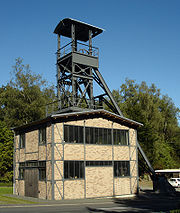
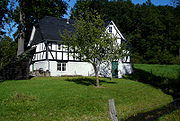
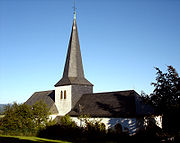

(500 BC). Witness thereto is the Iron-Age
blast furnace called Silberquelle ("Silver Source") on the Homberg in Wilnsdorf-Obersdorf.
was reconstructed on the old mine's lands, thereby recalling the region's almost 2500-year mining and smelting history. The 16 m-high tower with its shaft building is regarded as typical of mining works in the Siegerland, even though it is from outside the region.
and partly of cast iron
, is wholly preserved. The building date, however, is not exactly clear. It is documented that the mill was built in the first half of the 18th century, and local oral history holds that it was built in 1729.
artistry are exhibited. Moreover, there is a 19th-century schoolroom built true to the original. Before the building stands a statue of a miner and his mining cart. In an outbuilding, many agricultural devices are to be seen.
s and Protestants, a new church was built in 1787-1788 west of the tower, putting the church tower in the middle of the building, where it could be used by both denominations, standing as a symbol of a readiness between the two groups to compromise.
place comes from the year 1684. To this pilgrimage place belong a chapel
, a saint's cottage with a hermit's grave, a way of the Cross, a forest altar and a hermitage. In the chapel is an altar from 1736. The hermitage is among the Siegerland's oldest half-timbered
houses.
The Eremitage pilgrimage place was expanded in 1953 with the founding of an Order of Poor Ladies
convent.
) L 907 is the Rieselwiese, a meadow dating from 1996. As making charcoal
was so important to iron smelting and woods could therefore not be cleared, there was a dearth of hay
meadows for growing livestock fodder. For this reason, the few meadows on the valley floors were watered by the Siegerland farmers using a complex system so as to make them more fruitful with the suspended matter and minerals in the water. By doing this, they raised winter fodder yields by a third.
right near which, in September 2005, a service centre
– an Autohof, meaning one that does not have its own on- and off-ramps – with a filling station
, a hotel
and several restaurant
s opened.
Siegen-Wittgenstein
Siegen-Wittgenstein is a Kreis in the southeast of North Rhine-Westphalia, Germany. Neighboring districts are Olpe, Hochsauerlandkreis, Waldeck-Frankenberg, Marburg-Biedenkopf, Lahn-Dill, Westerwaldkreis, Altenkirchen.-History:...
, in North Rhine-Westphalia
North Rhine-Westphalia
North Rhine-Westphalia is the most populous state of Germany, with four of the country's ten largest cities. The state was formed in 1946 as a merger of the northern Rhineland and Westphalia, both formerly part of Prussia. Its capital is Düsseldorf. The state is currently run by a coalition of the...
, Germany
Germany
Germany , officially the Federal Republic of Germany , is a federal parliamentary republic in Europe. The country consists of 16 states while the capital and largest city is Berlin. Germany covers an area of 357,021 km2 and has a largely temperate seasonal climate...
.
Geography
The southern municipal limits, with the Kalteiche peak, part of the RothaargebirgeRothaargebirge
The Rothaargebirge is a low mountain range reaching heights of up to 843.1 m in North Rhine-Westphalia and Hesse, Germany....
, form not only the community's highest point, at 579 m above sea level
Sea level
Mean sea level is a measure of the average height of the ocean's surface ; used as a standard in reckoning land elevation...
, but also the boundary between Hesse
Hesse
Hesse or Hessia is both a cultural region of Germany and the name of an individual German state.* The cultural region of Hesse includes both the State of Hesse and the area known as Rhenish Hesse in the neighbouring Rhineland-Palatinate state...
(Lahn-Dill-Kreis
Lahn-Dill-Kreis
Lahn-Dill is a Kreis in the west of Hesse, Germany. Neighboring districts are Siegen-Wittgenstein, Marburg-Biedenkopf, Gießen, Wetteraukreis, Hochtaunuskreis, Limburg-Weilburg, Westerwaldkreis.-History:...
) and North Rhine-Westphalia. The heights lie between 290 m above sea level and 579 m at the Kalteiche.
Constituent communities

| Constituent communities | ||
|---|---|---|
| Anzhausen | Flammersbach | |
| Gernsdorf | Niederdielfen | |
| Oberdielfen | Obersdorf/Rödgen | |
| Rinsdorf | Rudersdorf | |
| Wilden | Wilgersdorf Wilgersdorf Wilgersdorf is a village in the district Siegen-Wittgenstein in North Rhine-Westphalia, Germany.Apart from that, it is also the biggest part of the municipality Wilnsdorf.- Geography :... |
|
| Wilnsdorf | ||
Niederdielfen and Oberdielfen are named for the River Dielfe, which flows through them. Niederdielfen was also the home of the painter Adolf Saenger, after whom the street Adolf-Saenger-Weg in Niederdielfen is named.
Population
(in each case at 31 December)
|
|
History
Wilnsdorf had its first documentary mention in 1185 under the name Willelmesdorf. A further form of the community's name is also recorded, Wielandisdorf, which is based on a local legend about a blacksmithBlacksmith
A blacksmith is a person who creates objects from wrought iron or steel by forging the metal; that is, by using tools to hammer, bend, and cut...
named Wieland (also known as Weyland
Weyland
In Germanic and Norse mythology, Wayland the Smith is a legendary master blacksmith. In Old Norse sources, Völundr appears in Völundarkviða, a poem in the Poetic Edda, and in Þiðrekssaga, and his legend is also depicted on the Ardre image stone VIII...
in English
English language
English is a West Germanic language that arose in the Anglo-Saxon kingdoms of England and spread into what was to become south-east Scotland under the influence of the Anglian medieval kingdom of Northumbria...
) who, according to local lore, lived nearby. It is true that iron
Iron
Iron is a chemical element with the symbol Fe and atomic number 26. It is a metal in the first transition series. It is the most common element forming the planet Earth as a whole, forming much of Earth's outer and inner core. It is the fourth most common element in the Earth's crust...
mining
Mining
Mining is the extraction of valuable minerals or other geological materials from the earth, from an ore body, vein or seam. The term also includes the removal of soil. Materials recovered by mining include base metals, precious metals, iron, uranium, coal, diamonds, limestone, oil shale, rock...
and smelting
Smelting
Smelting is a form of extractive metallurgy; its main use is to produce a metal from its ore. This includes iron extraction from iron ore, and copper extraction and other base metals from their ores...
had their beginnings in Wilnsdorf, and throughout the Siegerland, many centuries ago. History first mentions a mine in what is today the community's municipal area in 1298.
Between the late 12th century and the mid 17th century, the castle
Castle
A castle is a type of fortified structure built in Europe and the Middle East during the Middle Ages by European nobility. Scholars debate the scope of the word castle, but usually consider it to be the private fortified residence of a lord or noble...
and stately home of the Knights of Kolbe were to be found in Wilnsdorf. They were at this time the Vögte ( ≈ reeves) of the Princes of Nassau-Siegen over broad parts of the Siegerland. In Napoleonic Times, Wilnsdorf, like the rest of the Siegerland, lay under the rule of the Grand Duchy of Berg
Berg (state)
Berg was a state – originally a county, later a duchy – in the Rhineland of Germany. Its capital was Düsseldorf. It existed from the early 12th to the 19th centuries.-Ascent:...
.
In the early 19th century, the communities of Eisern, Obersdorf-Rödgen, Rinsdorf, Wilgersdorf, Wilnsdorf, Niederdielfen and Oberdielfen, by now all in Prussia
Prussia
Prussia was a German kingdom and historic state originating out of the Duchy of Prussia and the Margraviate of Brandenburg. For centuries, the House of Hohenzollern ruled Prussia, successfully expanding its size by way of an unusually well-organized and effective army. Prussia shaped the history...
, were united under the Amt
Amt (subnational entity)
Amt is a type of administrative division governing a group of municipalities, today only found in Germany, but formerly also common in northern European countries. Its size and functions differ by country and the term is roughly equivalent to a U.S...
of Wilnsdorf. Later, the community of Wilden, formerly part of the Amt of Burbach, was also included in the Amt of Wilnsdorf.
In 1957, mining in Wilnsdorf came to an end, and the last iron mine was shut down. On 1 January 1969, the formerly independent municipalities in the Amt were united to form the greater community of Wilnsdorf, the only exception being Eisern, which went to the town (now city) of Siegen
Siegen
Siegen is a city in Germany, in the south Westphalian part of North Rhine-Westphalia.It is located in the district of Siegen-Wittgenstein in the Arnsberg region...
. The municipal head from 1969 until 2004, first as community director and then as mayor, was Karl Schmidt, who after retiring was made the community's first honorary citizen.
Gernsdorf
Gernsdorf was likely first settled sometime about 800 or 900. About 1300, Gernsdorf had its first documentary mention under the name "Gernstorff". About six years later, likewise through a document, the name "Herman von Gernstorf" crops up.Municipal council

| CDU Christian Democratic Union (Germany) The Christian Democratic Union of Germany is a Christian democratic and conservative political party in Germany. It is regarded as on the centre-right of the German political spectrum... |
SPD Social Democratic Party of Germany The Social Democratic Party of Germany is a social-democratic political party in Germany... |
Greens Alliance '90/The Greens Alliance '90/The Greens is a green political party in Germany, formed from the merger of the German Green Party and Alliance 90 in 1993. Its leaders are Claudia Roth and Cem Özdemir... |
FDP Free Democratic Party (Germany) The Free Democratic Party , abbreviated to FDP, is a centre-right classical liberal political party in Germany. It is led by Philipp Rösler and currently serves as the junior coalition partner to the Union in the German federal government... |
UWG | total | |
| 2004 | 22 | 8 | 2 | 4 | 0 | 36 |
Note: UWG is a citizens' coalition.
Coat of arms

Coat of arms
A coat of arms is a unique heraldic design on a shield or escutcheon or on a surcoat or tabard used to cover and protect armour and to identify the wearer. Thus the term is often stated as "coat-armour", because it was anciently displayed on the front of a coat of cloth...
showed a crescent in the chief, but these arms were dropped in 1969 after amalgamation, losing their legal validity http://www.wilnsdorf.de/allgemeines/p_geschi.htm, and the current coat of arms, identical to that formerly borne by the now abolished Amt of Wilnsdorf, might heraldically be described thus: Party per fess, above, in azure a lion rampant Or armed and langued gules with seven billets Or, below, party per fess, above in argent two pallets sable, below, in sable two pallets argent.
The lion is from Nassau's arms, the colours blue and gold (or yellow) being Nassau's colours. The lower part of the shield comes from the arms of the Knights of Kolbe.http://www.ngw.nl/int/dld/w/wilnsdor.htm
forum kultur wilnsdorf
Near the municipal hall is the forum kultur wilnsdorf – customarily written with lowercase initial letters – consisting of a folkloreFolklore
Folklore consists of legends, music, oral history, proverbs, jokes, popular beliefs, fairy tales and customs that are the traditions of a culture, subculture, or group. It is also the set of practices through which those expressive genres are shared. The study of folklore is sometimes called...
museum and a cultural history meeting place. The folklore museum offers, on two floors, realistic looks into many fields of life and work in the southern Siegerland in the early 20th century. A separate exhibition recalls mining times in the Siegerland. A nature study cabinet exposes the visitor to the Siegerland's insect and plant life.
The cultural history meeting place affords one a "trip through time": from geology
Geology
Geology is the science comprising the study of solid Earth, the rocks of which it is composed, and the processes by which it evolves. Geology gives insight into the history of the Earth, as it provides the primary evidence for plate tectonics, the evolutionary history of life, and past climates...
through the Stone Age
Stone Age
The Stone Age is a broad prehistoric period, lasting about 2.5 million years , during which humans and their predecessor species in the genus Homo, as well as the earlier partly contemporary genera Australopithecus and Paranthropus, widely used exclusively stone as their hard material in the...
and the ancient civilizations and into the Middle Ages
Middle Ages
The Middle Ages is a periodization of European history from the 5th century to the 15th century. The Middle Ages follows the fall of the Western Roman Empire in 476 and precedes the Early Modern Era. It is the middle period of a three-period division of Western history: Classic, Medieval and Modern...
and modern times. Changing special exhibitions deepen and broaden the range of offerings.
Sightseeing




Obersdorf Iron-Age smelting furnace
Since iron ore was to be found quite near the surface and recovered without complicated mining procedures, the era of iron smelting in the Siegerland goes right back to La Tène timesLa Tène culture
The La Tène culture was a European Iron Age culture named after the archaeological site of La Tène on the north side of Lake Neuchâtel in Switzerland, where a rich cache of artifacts was discovered by Hansli Kopp in 1857....
(500 BC). Witness thereto is the Iron-Age
Iron Age
The Iron Age is the archaeological period generally occurring after the Bronze Age, marked by the prevalent use of iron. The early period of the age is characterized by the widespread use of iron or steel. The adoption of such material coincided with other changes in society, including differing...
blast furnace called Silberquelle ("Silver Source") on the Homberg in Wilnsdorf-Obersdorf.
Niederdielfen headframe
Within today's community of Wilnsdorf, eight mines were in operation into the early 20th century. The original headframe at the 'Grimberg' mine in Niederdielfen was torn down in 1911 when the mine shut down. In 1995, the headframe from the Julianschacht in BensbergBergisch Gladbach
' is a city in the Cologne/Bonn Region of North Rhine-Westphalia, Germany and capital of the Rheinisch-Bergischer Kreis .-Geography:Bergisch Gladbach is located east of the river Rhine, approx...
was reconstructed on the old mine's lands, thereby recalling the region's almost 2500-year mining and smelting history. The 16 m-high tower with its shaft building is regarded as typical of mining works in the Siegerland, even though it is from outside the region.
Niederdielfen watermill
The mill, lying on the Filsbachtälchen ("small Filsbach valley") and built in the first half of the 18th century, was restored to working condition in 1992-1993 and can be visited while it is working several times a year. The mill's grinding gear, including mechanical works made partly of wrought ironWrought iron
thumb|The [[Eiffel tower]] is constructed from [[puddle iron]], a form of wrought ironWrought iron is an iron alloy with a very low carbon...
and partly of cast iron
Cast iron
Cast iron is derived from pig iron, and while it usually refers to gray iron, it also identifies a large group of ferrous alloys which solidify with a eutectic. The color of a fractured surface can be used to identify an alloy. White cast iron is named after its white surface when fractured, due...
, is wholly preserved. The building date, however, is not exactly clear. It is documented that the mill was built in the first half of the 18th century, and local oral history holds that it was built in 1729.
Heimatstube Rinsdorf
In the "Rinsdorf Local History Parlour", built in 1791, originally as a chapel school, documents and tools from the region's mining history and Siegerland handicraftHandicraft
Handicraft, more precisely expressed as artisanic handicraft, sometimes also called artisanry, is a type of work where useful and decorative devices are made completely by hand or by using only simple tools. It is a traditional main sector of craft. Usually the term is applied to traditional means...
artistry are exhibited. Moreover, there is a 19th-century schoolroom built true to the original. Before the building stands a statue of a miner and his mining cart. In an outbuilding, many agricultural devices are to be seen.
Wilden village smithy
This smithy from the mid 19th century is almost fully preserved thanks to the Wildener Heimatverein's efforts and can even be seen working on special occasions. The smithy originally stood in the Köhlerweg ("Charcoal Maker Way"), but was moved to the middle of Wilden and reconstructed there in 1984.Wilnsdorf Arrest Building
The Arrestgebäude is one of the very few fully preserved buildings of its kind and is a good example of police work in the 19th century. Between 1839 and 1959, the building was used as an arrest building and offers a glimpse into penal enforcement in those days.Rödgen parish church
The parish church in Rödgen was first mentioned in a document on 4 March 1328. The old church was torn down in 1778 because it had become run down, and between 1779 and 1782 it was built anew in its current form. Owing to a dispute between CatholicCatholic
The word catholic comes from the Greek phrase , meaning "on the whole," "according to the whole" or "in general", and is a combination of the Greek words meaning "about" and meaning "whole"...
s and Protestants, a new church was built in 1787-1788 west of the tower, putting the church tower in the middle of the building, where it could be used by both denominations, standing as a symbol of a readiness between the two groups to compromise.
- Church tower – The church tower itself stands on a RomanesqueRomanesque architectureRomanesque architecture is an architectural style of Medieval Europe characterised by semi-circular arches. There is no consensus for the beginning date of the Romanesque architecture, with proposals ranging from the 6th to the 10th century. It developed in the 12th century into the Gothic style,...
foundation. At the tower is a memorial plaque from 1765 with a LatinLatinLatin is an Italic language originally spoken in Latium and Ancient Rome. It, along with most European languages, is a descendant of the ancient Proto-Indo-European language. Although it is considered a dead language, a number of scholars and members of the Christian clergy speak it fluently, and...
inscription. The tower's base covers an area of 4.7 × 4.7 m. The carillonCarillonA carillon is a musical instrument that is typically housed in a free-standing bell tower, or the belfry of a church or other municipal building. The instrument consists of at least 23 cast bronze, cup-shaped bells, which are played serially to play a melody, or sounded together to play a chord...
consists of three bells. The oldest, from 1515, is rung to call worshippers to the AngelusAngelusThe Angelus is a Christian devotion in memory of the Incarnation. The name Angelus is derived from the opening words: Angelus Domini nuntiavit Mariæ The Angelus (Latin for "angel") is a Christian devotion in memory of the Incarnation. The name Angelus is derived from the opening words: Angelus...
, weighs 723 kg, and has no particular name. There is also a verse by the Oberdorf poet Wilhelm Schmidt inscribed on the bell. - EvangelicalEvangelical Church in GermanyThe Evangelical Church in Germany is a federation of 22 Lutheran, Unified and Reformed Protestant regional church bodies in Germany. The EKD is not a church in a theological understanding because of the denominational differences. However, the member churches share full pulpit and altar...
part – The building of the older, Evangelical church is 23 m long and about 13 m wide. The building is shaped by the slender, high windows. The original organOrgan (music)The organ , is a keyboard instrument of one or more divisions, each played with its own keyboard operated either with the hands or with the feet. The organ is a relatively old musical instrument in the Western musical tradition, dating from the time of Ctesibius of Alexandria who is credited with...
, built in 1680, was installed in the newer church building in 1782, but was replaced with a new one in 1858. The Röver organ in the church at the moment, from 1899, is a rarity in Westphalia. - Catholic part – The wing built in 1788 exhibits a clear rectangular base 18.2 m long and 9.2 m wide. It was extended by a fourth window shaft in 1938.
Eremitage
The Eremitage pilgrimagePilgrimage
A pilgrimage is a journey or search of great moral or spiritual significance. Typically, it is a journey to a shrine or other location of importance to a person's beliefs and faith...
place comes from the year 1684. To this pilgrimage place belong a chapel
Chapel
A chapel is a building used by Christians as a place of fellowship and worship. It may be part of a larger structure or complex, such as a church, college, hospital, palace, prison or funeral home, located on board a military or commercial ship, or it may be an entirely free-standing building,...
, a saint's cottage with a hermit's grave, a way of the Cross, a forest altar and a hermitage. In the chapel is an altar from 1736. The hermitage is among the Siegerland's oldest half-timbered
Timber framing
Timber framing , or half-timbering, also called in North America "post-and-beam" construction, is the method of creating structures using heavy squared off and carefully fitted and joined timbers with joints secured by large wooden pegs . It is commonplace in large barns...
houses.
The Eremitage pilgrimage place was expanded in 1953 with the founding of an Order of Poor Ladies
Order of Poor Ladies
The Poor Clares also known as the Order of Saint Clare, the Order of Poor Ladies, the Poor Clare Sisters, the Clarisse, the Minoresses, the Franciscan Clarist Congregation, and the Second Order of St. Francis, , comprise several orders of nuns in the Catholic Church...
convent.
Rieselwiese
In Rinsdorf on state road (LandesstraßeLandesstraße
Landesstraßen are roads in Germany and Austria that are, as a rule, the responsibility of the respective German or Austrian federal state. The term may therefore be translated as "state road". They are roads that cross the boundary of a rural or urban district...
) L 907 is the Rieselwiese, a meadow dating from 1996. As making charcoal
Charcoal
Charcoal is the dark grey residue consisting of carbon, and any remaining ash, obtained by removing water and other volatile constituents from animal and vegetation substances. Charcoal is usually produced by slow pyrolysis, the heating of wood or other substances in the absence of oxygen...
was so important to iron smelting and woods could therefore not be cleared, there was a dearth of hay
Hay
Hay is grass, legumes or other herbaceous plants that have been cut, dried, and stored for use as animal fodder, particularly for grazing livestock such as cattle, horses, goats, and sheep. Hay is also fed to pets such as rabbits and guinea pigs...
meadows for growing livestock fodder. For this reason, the few meadows on the valley floors were watered by the Siegerland farmers using a complex system so as to make them more fruitful with the suspended matter and minerals in the water. By doing this, they raised winter fodder yields by a third.
Transport
Wilnsdorf lies on Federal Highway (Bundesstraße) B 54 and has at its disposal its own Autobahn interchange on the A45Bundesautobahn 45
is an autobahn in Germany, connecting Dortmund in the west with Aschaffenburg in the southwest. It is colloquially known by its byname Sauerlandlinie, which derives from the Sauerland, the landscape which said autobahn is running through between the cities of Hagen and Siegen. Many people think of...
right near which, in September 2005, a service centre
Rest area
A rest area, travel plaza, rest stop, or service area is a public facility, located next to a large thoroughfare such as a highway, expressway, or freeway at which drivers and passengers can rest, eat, or refuel without exiting on to secondary roads...
– an Autohof, meaning one that does not have its own on- and off-ramps – with a filling station
Filling station
A filling station, also known as a fueling station, garage, gasbar , gas station , petrol bunk , petrol pump , petrol garage, petrol kiosk , petrol station "'servo"' in Australia or service station, is a facility which sells fuel and lubricants...
, a hotel
Hotel
A hotel is an establishment that provides paid lodging on a short-term basis. The provision of basic accommodation, in times past, consisting only of a room with a bed, a cupboard, a small table and a washstand has largely been replaced by rooms with modern facilities, including en-suite bathrooms...
and several restaurant
Restaurant
A restaurant is an establishment which prepares and serves food and drink to customers in return for money. Meals are generally served and eaten on premises, but many restaurants also offer take-out and food delivery services...
s opened.
Sons and daughters of the community
- Karl Schmidt, honorary citizen of Wilnsdorf, community director and later mayor from 1969 to 2004
- Gerhard Neuser, former footballFootball (soccer)Association football, more commonly known as football or soccer, is a sport played between two teams of eleven players with a spherical ball...
player with Sportfreunde SiegenSportfreunde SiegenSportfreunde Siegen is a German association football club based in Siegen, North Rhine-Westphalia. The club was founded in 1899 as the football department of the gymnastics club Turn Verein Jahn von 1879 Siegen...
and FC Schalke 04FC Schalke 04Fußball-Club Gelsenkirchen-Schalke 04, commonly known as simply FC Schalke 04 or Schalke , is a German, association-football club originally from the Schalke district of Gelsenkirchen, North Rhine-Westphalia. Schalke has long been one of the most popular football teams in Germany, even though major...

